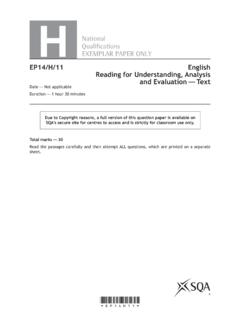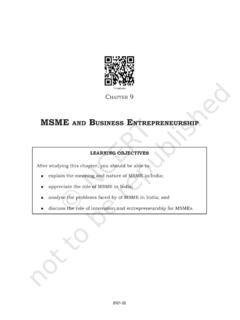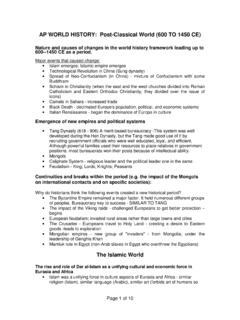Transcription of A new model for Vietnam’s economic growth in 2021-2030 ...
1 Final report Small research and development activity project A new model for Vietnam s economic growth in 2021-2030 (investment targeting based on regional comparative advantages) and vision to 2050: Quantitative scenario assessment project number AGB/2020/122 date published 23 February 2021 prepared by Long Chu co-authors/ contributors/ collaborators Son Dang, Khoi Dang, Thai Nguyen, Quoc Anh Ho, Thuy Do, Duc Anh Dang, Chi Pho, Thang Tran approved by final report number FR2021-003 ISBN 978-1-922345-89-9 published by ACIAR GPO Box 1571 Canberra ACT 2601 Australia This publication is published by ACIAR ABN 34 864 955 427. Care is taken to ensure the accuracy of the information contained in this publication. However ACIAR cannot accept responsibility for the accuracy or completeness of the information or opinions contained in the publication. You should make your own enquiries before making decisions concerning your interests.
2 Australian Centre for International Agricultural Research (ACIAR) 2021 - This work is copyright. Apart from any use as permitted under the Copyright Act 1968, no part may be reproduced by any process without prior written permission from ACIAR, GPO Box 1571, Canberra ACT 2601, Australia, Final report: A new model for Vietnam s economic growth in 2021-2030 (target-investment policy based on regional comparative advantages) and vision to 2050: Quantitative scenario assessment Page ii Contents 1 Acknowledgments .. 4 2 Executive 6 Background of this project .. 6 What has been done in this project .. 7 Contribution of this project .. 8 Summary of key findings .. 9 Policy implications and vision beyond 2030 .. 14 3 Introduction .. 17 4 Summary of project objectives and policy impacts in relation to ACIAR goals .. 19 5 Impact of COVID-19 on the research project .. 20 6 Methodological review on quantitative impact evaluation.
3 21 7 Non-technical summary of the modelling framework .. 23 8 Overview of Vietnam s regional economies .. 27 Regional economic performance by output .. 27 Regional allocation of production factors .. 28 Labour income, rental rate, and agricultural land 28 9 Policy scenarios .. 30 Business-As-Usual scenario .. 30 Target-investment policy .. 31 10 Results .. 32 Impacts on real GDP .. 32 Impacts on sectoral growth .. 34 Impact on regional economies .. 35 Impacts on the agricultural sector .. 36 11 Policy implications and visions beyond 2030 .. 39 12 Conclusions and recommendations for future 41 13 References .. 42 14 Appendixes .. 46 Appendix A1: List of sectors and regions .. 46 Appendix A2: Mathematical specification of the Computable General Equilibrium 47 Appendix A3: Overview of Vietnam economic sectors in the base year 2018 .. 50 Final report: A new model for Vietnam s economic growth in 2021-2030 (target-investment policy based on regional comparative advantages) and vision to 2050: Quantitative scenario assessment Page 3 List of tables Table : Regional gain in GDP growth rate.
4 12 Table 1. Mapping of regional economic advantages .. 26 Table 2. Forecasted regional population growth rates .. 30 Table 3. BAU regional GDP growth rates .. 31 Table 4. Contribution of production factors to GDP growth rate .. 33 Table 5. Regional gain in GDP growth rate .. 36 Table A 1. List of economic sectors .. 46 Table A 2. List of provinces in each region .. 47 Table A 3. Sectoral share of gross output and GDP in 2018 (%) .. 50 Table A 4. Export and import structure in 2018 (%) .. 51 Table A 5. Structure of household income by source in 2018 .. 51 List of figures Figure : Regions of Vietnam (Decree 92/2006, clause 15) .. 8 Figure : Comparison of real GDP .. 9 Figure : Comparison of GDP growth rates .. 10 Figure : Current-value per-capita GDP under the US inflation rate of 2 per cent per annum .. 10 Figure : Sectoral annual growth rates .. 11 Figure : Impacts on the agricultural sector .. 12 Figure : Average real growth rate of salary in three agricultural hubs.
5 13 Figure : Average growth rate of the value-add of agricultural land in three agricultural hubs .. 14 Figure 1: Regions of Vietnam (Decree 92/2006, clause 15) .. 23 Figure 2: Comparison of real GDP .. 32 Figure 3: Comparison of GDP growth rates .. 33 Figure 4: Current-value per-capita GDP under the US inflation rate of 2 per cent per annum .. 34 Figure 5: Sectoral annual growth rates .. 35 Figure 6: Impacts on the agricultural sector .. 37 Figure 7: Average real growth rate of salary in three agricultural hubs .. 37 Figure 8: Average growth rate of the value-add of agricultural land in three agricultural hubs .. 38 Final report: A new model for Vietnam s economic growth in 2021-2030 (target-investment policy based on regional comparative advantages) and vision to 2050: Quantitative scenario assessment Page 4 1 Acknowledgments We acknowledge the funding from ACIAR for this research. We would like to thank experts from Vietnam s ministries and governmental departments for their insightful comments Final report: A new model for Vietnam s economic growth in 2021-2030 (target-investment policy based on regional comparative advantages) and vision to 2050: Quantitative scenario assessment Page 5 Author contribution statement: Long Chu and Son Dang conceived the research idea and led the research team in Australia and Vietnam respectively.
6 Long Chu devised the modelling framework. Khoi Dang collected and compiled data. Thai Nguyen, Quoc Anh Ho, and Thuy Do handled data processing and summarised literature. Long Chu, Son Dang, Khoi Dang, Duc Anh Dang, Chi Pho, and Thang Tran constructed business-as-usual projections. Son Dang and Long Chu constructed and formalised policy responses. Long Chu calibrated the model and simulated policy impacts. Long Chu, Son Dang, Khoi Dang, Thai Nguyen, Quoc Anh Ho wrote the report. Author affiliation: Long Chu, Khoi Dang, Thai Nguyen, Quoc Anh Ho, Thuy Do: the Australian National University (Canberra, Australia). Son Dang: the Central Ideology Theoretical Council of the Communist Party of Vietnam (57 Phan Dinh Phung street, Ba Dinh district, Hanoi, Vietnam) Duc Anh Dang and Chi Pho: the National Center for Socio- economic Information and Forecast - the Ministry of Planning and Investment of Vietnam (Ton That Thuyet street, Cau Giay district, Hanoi, Vietnam) Thang Tran: the Institute of Policy and Strategy for agriculture and rural Development - the Ministry of agriculture and rural Development (16 Thuy Khue street, Ba Dinh district, Hanoi, Vietnam) Final report: A new model for Vietnam s economic growth in 2021-2030 (target-investment policy based on regional comparative advantages) and vision to 2050.
7 Quantitative scenario assessment Page 6 2 Executive summary Background of this project Rapid economic growth and escaping the middle-income trap are a top-priority objective of Vietnam. To achieve this objective, Vietnam has adopted the dual economy model where some geographical regions and economic sectors have been prioritised, and they can have a higher level of development compared to the rest of the economy. These prioritised regions and sectors were expected to lead the growth process and support other regions and sectors to achieve overall prosperity. The dual economy model has focused on industrialisation and urbanisation process over the last 20 years. As a result, some geographical regions have attracted more investments and have been growing at a two-digit rate. Some businesses have better access to resources ( , state-owned enterprises and large-scale private companies with broad social connections), and they have more advantages in competing with other enterprises.
8 The dual economy model in Vietnam, while showing some initial success, has caused significant issues (Dapice, 2003; Pincus, 2016). The country has uneven socio- economic developments, some regions are much more advanced and active while others are backward and passive. economic growth is mainly driven by natural resource exploitation and the exploitative growth has caused environmental problems. The contribution of high-quality labour and science remains limited. The income and social welfare gaps between rural and urban areas, and among geographical regions have widened. As a result, the economic growth has slowed down with no sign of improvements, while macroeconomic indicators are unstable with a large budget deficit and increasing public debt (Busch, 2017). This outcome is consistent with international lessons that the dual economy model , in most cases, will trap a country in a middle-income circle.
9 Also, the dual economy model , with its consequences of uneven development, might be the underlying reason for socio- economic and environmental crisis or even political instability. To address this challenge, the Central Ideology Theoretical Council of Vietnam (CITC) has been assigned responsibility for a new economic growth ideology model for Vietnam in the 2021-2030 decade. The objective of the new model is to help Vietnam successfully escape the middle-income trap and complete its industrialisation and urbanisation process. Experts of CITC has proposed an Inclusive Development Economy model where the key policy is to prioritise investment in sectors with economic advantages in each region of the country (referred to as target-investment policy). Successful implementation of this policy on the national scale would be a crucial content in the Document of 13th Party Congress in early 2021, and they will form the direction for the economic development of the country in the next ten years.
10 To support decision-making, it is important to have a high-quality quantitative assessment of the possible economic outcomes in different scenarios. This ACIAR-funded research develops a modelling framework to quantitatively evaluate the outcome of the target-investment policy. In the past, some research was undertaken to estimate the impact of a particular policy in Vietnam (Giesecke et al., 2013; Baker et al., 2014). However, the analytical frameworks used in these previous studies are generic, not originally constructed for Vietnam and, as a result, they are unable to take into account some specific but essential contexts of the country. This research constructs a modelling framework to take into account country-specific conditions and evaluate the impact of the target-investment policy in considered growth scenarios. Final report: A new model for Vietnam s economic growth in 2021-2030 (target-investment policy based on regional comparative advantages) and vision to 2050: Quantitative scenario assessment Page 7 What has been done in this project Reviewing and summarizing literature and knowledge base Consulting with Vietnam s ministries, governmental departments and experts on national practice and context Data gathering and cross-checking Constructing regional input-output matrix of Vietnam and consistency validating If inconsistency detected Developing a multi-region dynamic CGE model for policy impact evaluation to fit with Vietnam s context and data Consulting with Vietnam s ministries, governmental departments and experts to construct BAU projections Calibrating the model If inconsistency detected Test-run the model Simulation and evaluation of policy impacts Final report.



